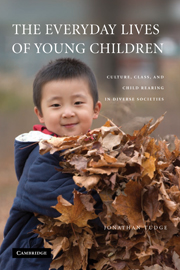Book contents
- Frontmatter
- Contents
- Preface
- Acknowledgments
- 1 Introduction and Stage Setting
- 2 The Daily Lives of Toddlers
- 3 Cultural–Ecological Theory and Its Implications for Research
- 4 Methods
- 5 Life in the Cities
- 6 Everyday Activities
- 7 Settings and Partners
- 8 Everyday Lives
- 9 The Cultural Ecology of Young Children
- References
- Index
1 - Introduction and Stage Setting
Published online by Cambridge University Press: 25 July 2009
- Frontmatter
- Contents
- Preface
- Acknowledgments
- 1 Introduction and Stage Setting
- 2 The Daily Lives of Toddlers
- 3 Cultural–Ecological Theory and Its Implications for Research
- 4 Methods
- 5 Life in the Cities
- 6 Everyday Activities
- 7 Settings and Partners
- 8 Everyday Lives
- 9 The Cultural Ecology of Young Children
- References
- Index
Summary
Because children grow up, we think a child's purpose is to grow up. But a child's purpose is to be a child. Nature doesn't disdain what lives only for a day. It pours the whole of itself into the each moment. We don't value the lily less for not being made of flint and built to last. Life's bounty is in its flow, later is too late.
Tom Stoppard, Shipwreck (2002, p. 100).BACKGROUND
How do young children spend their time? Who are the people with whom children are engaged in activities and interaction? In which sorts of activities do they get involved, and how do those activities get started? Where do they spend their time? Somewhat surprisingly, we don't have very good answers to these questions. And yet it is when children are young that it is relatively easy to see the ways in which parents and other people attempt to ensure that they become skilled in the practices that are considered important and to learn the values, concepts, and ways of behaving that are valued in the culture in which the children are situated. It is possible to see this by examining the types of activities in which children are encouraged to participate, the types of activities they are discouraged from, the people with whom it is considered appropriate to interact, and the roles played by those social partners.
- Type
- Chapter
- Information
- The Everyday Lives of Young ChildrenCulture, Class, and Child Rearing in Diverse Societies, pp. 1 - 21Publisher: Cambridge University PressPrint publication year: 2008



